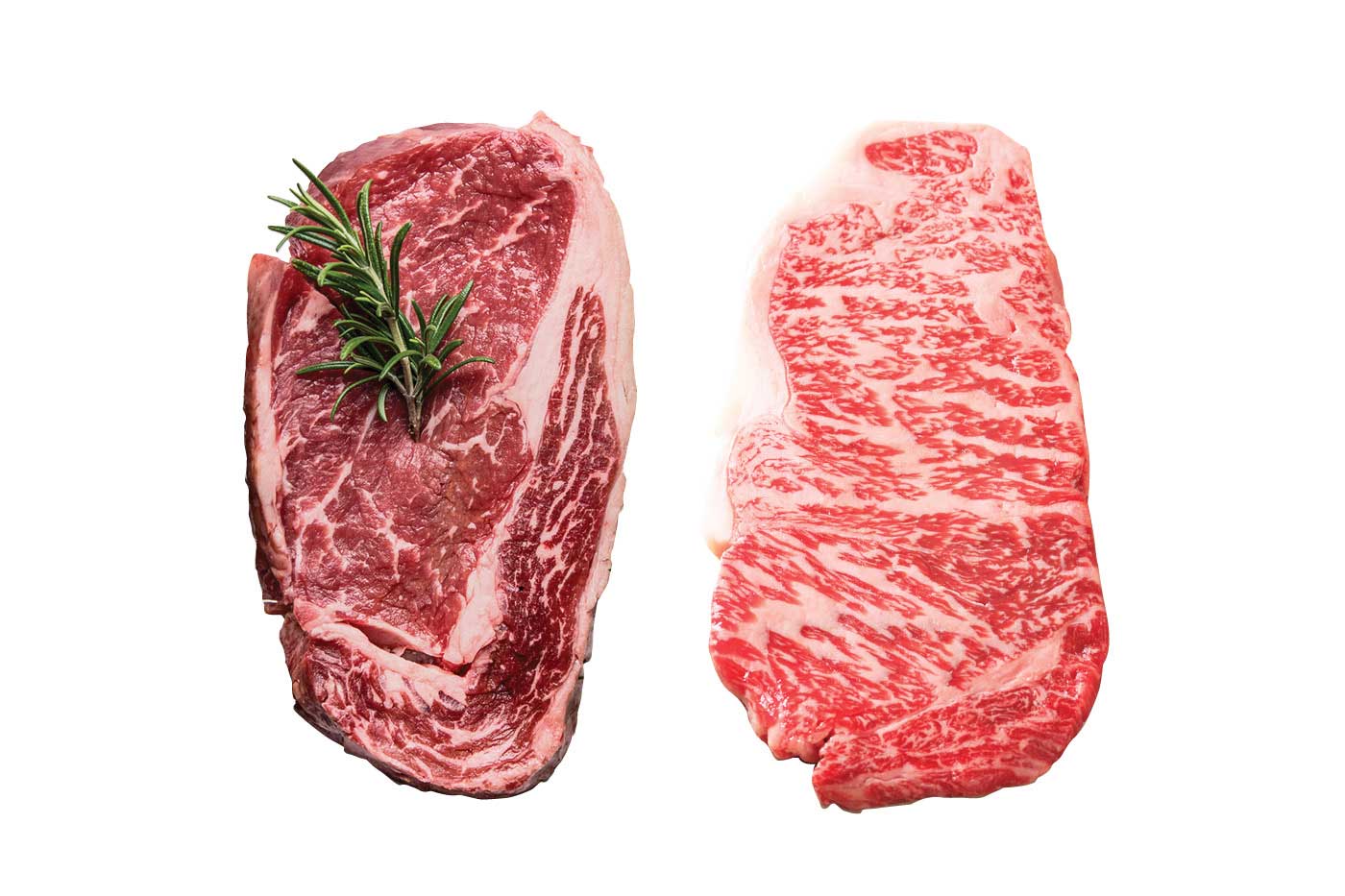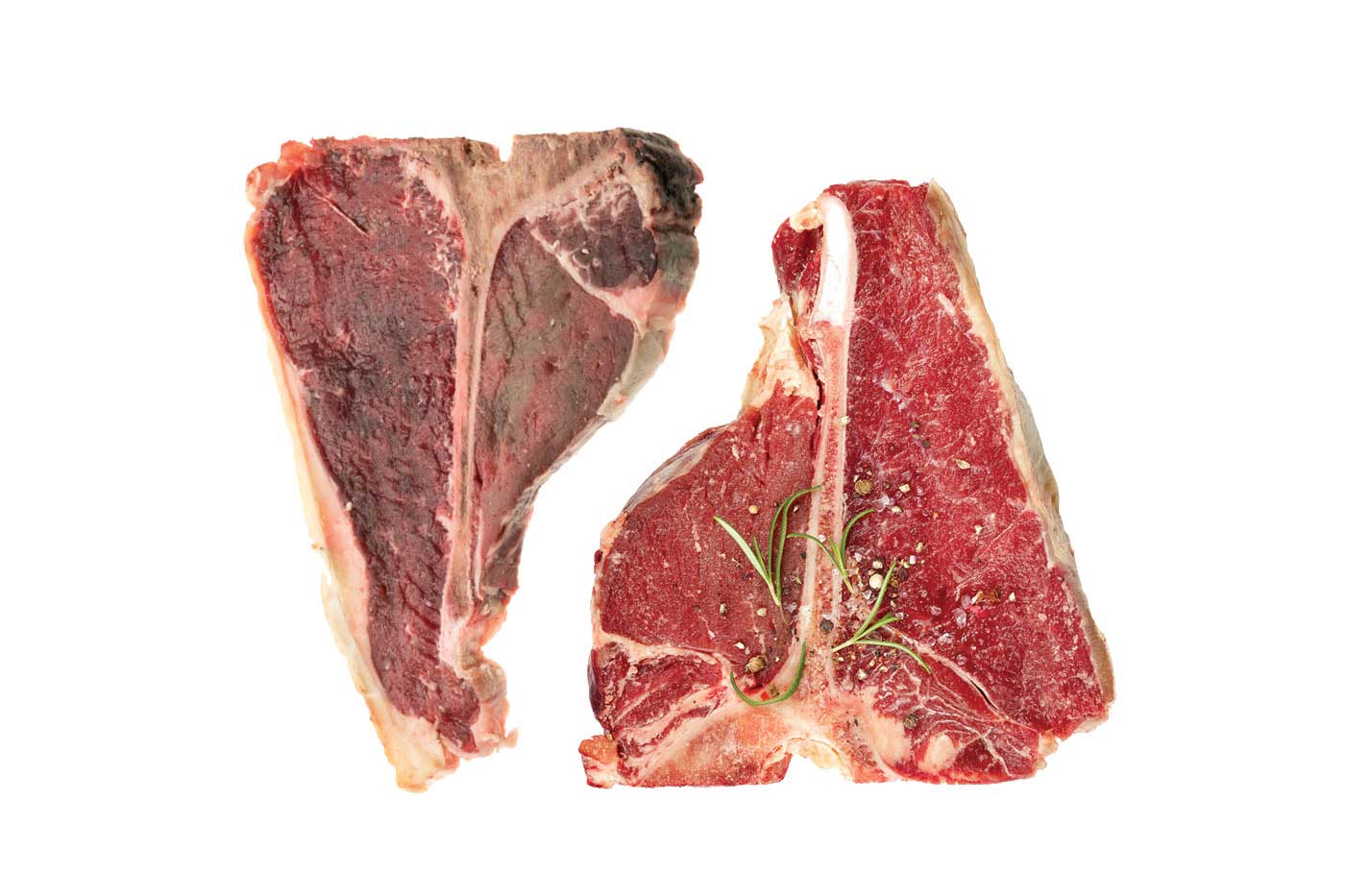Certified Angus. Canada Prime. Dry-aged. Grain-finished. Steak-house menus can be peppered with enough jargon to confound even the most seasoned carnivore. Can’t make heads or tails of it? Fear not! We’re here to help you beef up your game.
Angus vs. Wagyu

Black Angus is practically synonymous with Alberta beef. A Scottish breed, Angus cattle are especially hardy, making them a good fit for cold Canadian winters. Modern Steak owner Stephen Deere likens it to wine: “It’s about planting the right grapes in the right place, and Angus are just really good for our climate here.”
In recent years, however, Angus has been getting a little competition in the form of wagyu beef. Wagyu can come from any of four types of Japanese cattle, but its most distinctive feature is feed: wagyu cows are spoiled rotten their whole lives, feasting on barley usually until they’re fat and tender. That gourmet feed makes them more expensive, as does the time to market — where a grain-fed Angus takes about 16 months to reach your plate, wagyu can take up to three years. But did we mention how tasty they are? “Wagyu is a huge melt-in-the-mouth of rich, buttery steak, full of flavour,” says Squawma Kavanagh, executive chef
of Vintage Chophouse. And in case you’re feeling guilty about that extra fat content, apparently there are health benefits, too. “Wagyu contains a higher percentage of omega-3 and omega-6, and its increased marbling enhances the ratio of healthier monosaturated fats compared to regular beef.” We’ll take your word for it, Squawma, but you had us at “buttery.”
Dry-aged vs. Wet-aged

Though it might seem counterintuitive, your steak gets better with age. That’s because the aging process helps tenderize the meat, breaking down the connective tissue and bringing out the flavour.
Most beef is wet-aged, meaning it has been stored in a vacuum-sealed container for anywhere up to 28 days. John Jackson, chef and co-owner of Charcut reckons wet-aging works best for smaller, leaner cuts. “We also like it for prime rib, where it cooks at a much slower rate and requires a higher moisture content,” he says.
The gold standard, though, is dry-aging. By releasing moisture, dry-aging concentrates the flavour, leaving the meat firmer and, well, beefier. The longer the meat is aged, the more intense its flavour becomes, and the more weight it loses — sometimes up to 50 per cent of the original piece of beef. That makes it a much more resource-intensive process, which is why dry-aging is not as common. But the results are worth it, yielding a tender, incredibly flavourful piece of meat. And, as those who work with dry-aged beef know, the flavours can manifest in very interesting ways. “It’s really something special,” says Barb Steen, general manager at Hy’s Steakhouse. “At 60 days [of dry-aging], you actually get a hint of blue cheese.”
Grass-fed vs. Grain-fed
They say you are what you eat, and that’s as true for bovines as for Homo sapiens. Cattle fed exclusively on grass are leaner than those that have grain in their diets. Since marbling (a.k.a. fat) is tasty, grain-fed beef tends to be more flavourful, but many diners prize grass-fed beef as a leaner, healthier option — for humans, cows and Mother Earth.
Here in Alberta, cattle traditionally start out grass-fed and pasture-raised, taking full advantage of our natural prairie environment, before being “finished” on a grain-based diet. But unlike in the U.S. and eastern Canada, where “grain-fed” or “grain-finished” usually means corn, ’round these parts, it typically refers to barley. That rich, savoury barley flavour is what many consider to be the hallmark of Alberta beef. Grass or grain, Alberta cattle are getting the good stuff. “We have the best native grass in the world,” says Stephen Deere of Modern Steak. “We have the best water in the world and hands-down the best barley. The best inputs mean the best product.”
Prime vs. AAA, AA, A
This isn’t a matter of “versus,” but rather different grades on the same scale, referring to the quality of the beef as graded by the Canadian Beef Grading Agency. At the very top of the scale is “Prime,” representing the top two per cent of all beef. In second place is AAA, followed by AA and so on. The main criterion separating these grades is fat content. “What we’re really looking for in the meat is marbling,” says Connie Giannoulis-Stuart, co-owner of Caesar’s. The more marbling, the higher the grade. “Marbling enhances tenderness and flavour and keeps the meat moist when it’s cooking, especially at high temperatures,” says Squawma Kavanagh of Vintage. Since grass-fed beef tends to have a lower degree of marbling, savvy carnivores know that a Prime rating necessarily means grain-fed or grain-finished.
